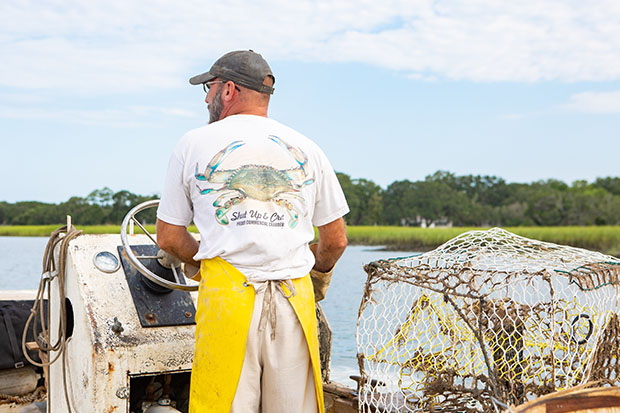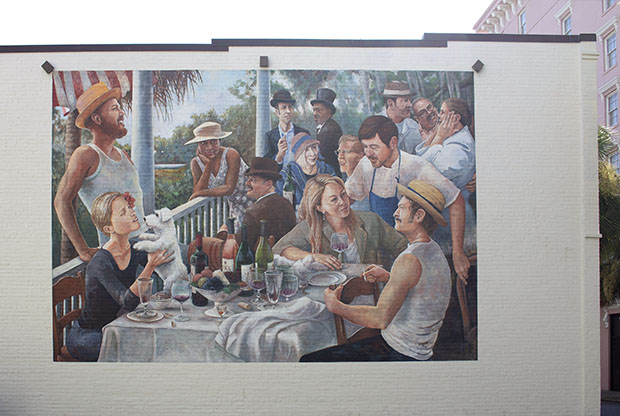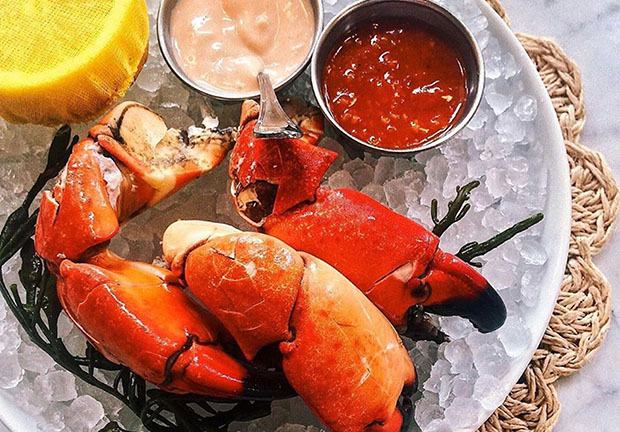Crabs are Calling
03 Sep 2020
A day in the life of a commercial crabber
by Jenny Peterson

The day starts early, at 5 a.m., before the Lowcountry heat sets in.
Setting up a flat-bottomed, bright white Carolina Skiff with various
wooden baskets for sorting their catch, Lowcountry commercial crabbers
JB Medlin and “Crazy Dave” Woolman set off to haul in crabs from
Lowcountry waters.
It’s a beautiful boat ride through creeks and rivers as they make
their way to a line of small bobbing buoys along the shore.
They wave and yell hello at boaters who recognize the crabbing team as they
passed.
Medlin’s crab traps were baited the day before with medium-sized whole menhaden fish placed into an interior compartment of each metal basket. The traps were then dropped to the bottom of the creek bed.
While it’s usually anyone’s guess whether or not crabs have been drawn into a trap, Medlin’s two decades of experience crabbing in Lowcountry waters has given him a good idea of where the crabs are biting.
Woolman, who has been crabbing for twice as long, previously ran Woolman’s Seafood on Folly.
“You've got to chase the crabs,” Medlin said.
The boat slows once they reach the line of buoys. It takes just seconds for Medlin to hook the buoy rope onto a crank outfitted on the skiff that lifts the large metal traps from the water.
The traps quickly rise to the surface, teeming with active blue crabs—claws at the ready.
Medlin grabs the trap off the hook and shakes out the catch into a basket onboard. The sound of crustacean shells tumbling down into the basket signals that today is a good day on the water.
As Medlin trolled the waterways picking up more traps, “Crazy Dave” gets to work, digging through the pile to sort the bounty—large male crabs go in one separate basket, large females in another, and a smaller sized mix of the two in a third.
Woolman uses heavy duty gloves and a metal measuring tool for sorting—all crabs must be five inches or longer—and throws back the ones that are undersized. It’s important, he says, to keep the balance of the crabs in the wild, to ensure reproduction.
For the stone crabs—brown and black dotted with comically large claws compared to their body—Woolman measures the claws first. Then he snaps off one of the crab’s large claws right on board and throws the crab back into the water, still alive.
That “snap” is important—“When you take it off, you need to hear a ‘pop,’” Woolman says. “If you do it wrong, they die.”
This method of saving the crabs gives them a chance to live and regrow the claw, and hopefully, come back to the trap again in the future.
There’s an art and timing to crabbing like this. There’s also knowledge about where crabs are biting. Traps are relocated when necessary, to shallower or deeper water, depending on the season.
At the end of the workday, around 2 p.m., the fishermen deliver their catch directly to local seafood markets, where blue crabs are sold live. The stone crab claws are sold at a premium—fresh crab meat
harvested just hours earlier.
Deep Crabbing History
Crabbing is in both Medlin and Woolman’s blood.
“My grandfather was a fish monger; my dad was a fish monger—everybody was a fish monger,” he said. His dad ran Captain Don’s Seafood in North Charleston for 20 years.
Medlin first got into crabbing in high school working for Woolman. After convincing him to go out of retirement, the two still crab together three times a week—this time on Medlin’s boat.
“You’ve got to like it,” Medlin said. “If you don’t, you’d never be able do it,” he said.
It’s not idyllic every day. Some days, they can’t catch enough to meet the market. Other times, the crabs aren’t biting, so they take a day off.
They’ve been through harder times, like a crab bait shortage—"If we get desperate, we use chicken,” Medlin says. There’s a concern of overfishing by recreational crabbers. Recreational fishermen with
valid South Carolina fishing licenses are allowed two crab traps.
They’ve been out on the water in freezing cold conditions, on windy days and rainy days, and on the hottest days of summer.
“What keeps me going is my Faith, family, being outside on the water, and being my own boss,” Medlin said. “You can’t ever take this for granted.”











